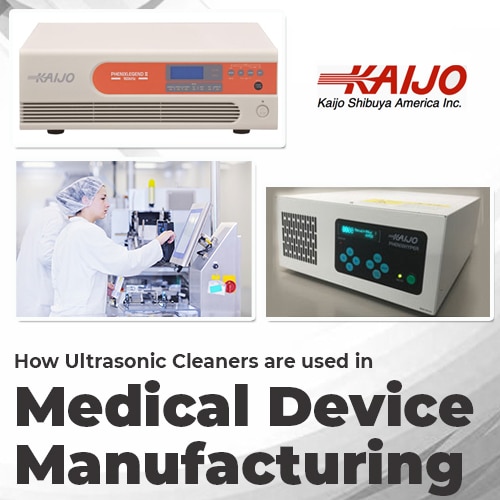How Ultrasonic Cleaners Are Used in Medical Device Manufacturing
November 17, 2021
 When medical equipment manufacturers assemble medical devices, they have to be sure that the components don’t introduce contamination into the finished product. Such contamination can include shop dirt, manufacturing residue, or metallic contamination from machining. The cleanliness of sub-supplier parts introduces additional uncertainty. When all components are cleaned prior to final assembly, medical device manufacturers can be sure that the product will not endanger patients.
When medical equipment manufacturers assemble medical devices, they have to be sure that the components don’t introduce contamination into the finished product. Such contamination can include shop dirt, manufacturing residue, or metallic contamination from machining. The cleanliness of sub-supplier parts introduces additional uncertainty. When all components are cleaned prior to final assembly, medical device manufacturers can be sure that the product will not endanger patients.
For sophisticated, modern medical devices, effective cleaning can present challenges. Components may be heat-sensitive and delicate. They may have soft coatings or easily damaged optical surfaces. Traditional steam cleaning and manual scrubbing can damage electronics and scratch screens, sensor surfaces, or optical fibers. Medical ultrasonic cleaners represent an ideal solution for cleaning such components. Ultrasonic cleaning takes place at room temperature and can be adjusted in intensity to avoid damage to soft or fragile components. In addition, ultrasonic cleaners remove contaminants more quickly and completely compared to traditional cleaning methods.
Ultrasonic Cleaners Can Clean Complex Shapes
Ultrasonic cleaners work by generating microscopic cavitation bubbles in the cleaning solution. The bubbles form and collapse in tune with the ultrasonic frequency. When a bubble collapses, it emits a powerful jet that dislodges contaminating material from the surface of the part to be cleaned. The scrubbing action delivered by the bubbles works quickly and completely to clean part surfaces.
Parts that have complex shapes are often hard to clean with traditional methods. Threaded holes, hinges, cavities, and rough surfaces can require hard scrubbing and special cleaning instruments or brushes. Components that make up medical devices are often especially hard to clean because they have shapes determined by their function. Implants, internal scopes, surgical instruments, and sampling devices must have contamination removed from any cracks, seams, crevices, or holes.
Because the cavitation bubbles appear wherever cleaning solution is present, ultrasonic cleaners can clean effectively inside cavities, along joints, and in dead-end holes. Parts cleaned with the right ultrasonic cleaner come out of the bath with all traces of contamination removed.
Cleaning Intensity Can Be Adjusted to Match Part Hardness and Strength
The cleaning intensity of medical ultrasonic cleaners depends on the size of the cavitation bubbles generated by the cleaner. Cleaners operating at high frequencies produce small bubbles and gentle cleaning action suitable for delicate components. Low-frequency cleaners clean more intensively and the comparatively large bubbles they generate deliver a powerful scrubbing action. The lowest frequencies, at about 20 kHz, produce large bubbles that can result in pitting and mechanical damage for soft surfaces or delicate components.
To make sure the cleaning intensity corresponds to the requirements of the cleaning application, choosing the right frequency is critical. Components such as optical fibers may have delicate surfaces while implants can have a soft coating. Electronic components are often delicate and instruments can be fragile. An experienced medical ultrasonic cleaner manufacturer can help ensure the chosen frequency delivers fast cleaning action without damaging the parts to be cleaned.
Kaijo Can Help Choose the Right Medical Ultrasonic Cleaner
As one of the leading ultrasonic equipment manufacturers, Kaijo can help medical device manufacturers transition to ultrasonic cleaners and make sure the systems they choose deliver the required cleaning performance. Kaijo has a complete line of ultrasonic cleaners and components that can be customized to meet the unique requirements of medical device manufacturers. Kaijo’s experts can analyze a customer’s needs, recommend cleaners with the appropriate frequency and suggest custom features to match the medical cleaning application. When Kaijo’s systems are used by medical manufacturers they can be sure that their components and devices will be cleaned to meet their requirements.





